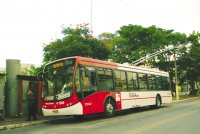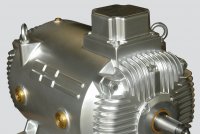Trolleybus
With a useful life of approximately 25 years, the vehicle has one of its differentials in the inverter & motor assembly, which is more powerful, lighter and more economical. The Trolleybus, popularly known as the electric bus, is apparently the same as the others. However, its great difference is in the motor (with inverter) which is driven by electricity, received from an aerial network.
For large cities, where mass transit is indispensable in citizens’ daily life, the Trolleybus represents an excellent solution for energy savings and for improvement of the environment, reducing air pollution, for it does not release the particles that arise from combustion engines. In addition, it also guarantees a more comfortable trip because the vehicle is more silent than conventional buses.
For this type of application, WEG has just introduced one more option for a traction motor (three phase, totally closed) with power up to 185kW, extremely light and compact, in a cast water-cooled housing. This represents a reduction of 400 kg, just in motor weight.
For manufacturers of Trolleybus, partners like Busscar, Tutto, Eletra and Ibrava, WEG has involved and made a great deal of movement of its engineering team, to develop and adjust the products and software for the solution of each client. The powertrain (AC traction motor and microprocessor controlled vector frequency inverter PLC) is the main WEG component in these vehicles.
Hybrid Bus
The traction motor of 185kW and the vector inverter CFW09 of 600A, dedicated to this application, form a robust powertrain, able to make the bus “squeal its tires” on starting out. However, for normal operations, we limit the maximum torque to avoid unnecessary wear. The traction system also has a generator group (alcohol or gas) which feeds a battery bank, responsible for supplying power to the traction system and for the auxiliary services of the bus.
This type of vehicle may be expanded and become biarticulated, with two bellows, in which it is possible to transport up to 300 people, emitting 80% fewer pollutants than conventional systems and consuming 50% less fuel.
Streetcars
Registered as a part of the historical heritage, the Santa Teresa Streetcar (Bonde de Santa Teresa) is a “treasure” of Rio de Janeiro. It is a mistake to think that it is only for tourists, because for the population of the Santa Teresa neighborhood and region, the Streetcar is one of the main means of transportation.
And, for WEG, it is a point of pride to be able to say that it is part of this history, since it is participating in the renovation of the city’s streetcars. The new vehicles are equipped with two special traction Motors of 70kW each, and one traction inverter of 450A.
For those who have not yet had the opportunity to go to Rio de Janeiro, when you go, don’t miss taking a marvelous streetcar ride in Santa Teresa, enjoying the beautiful view from the top of the mountain of the marvelous city.






